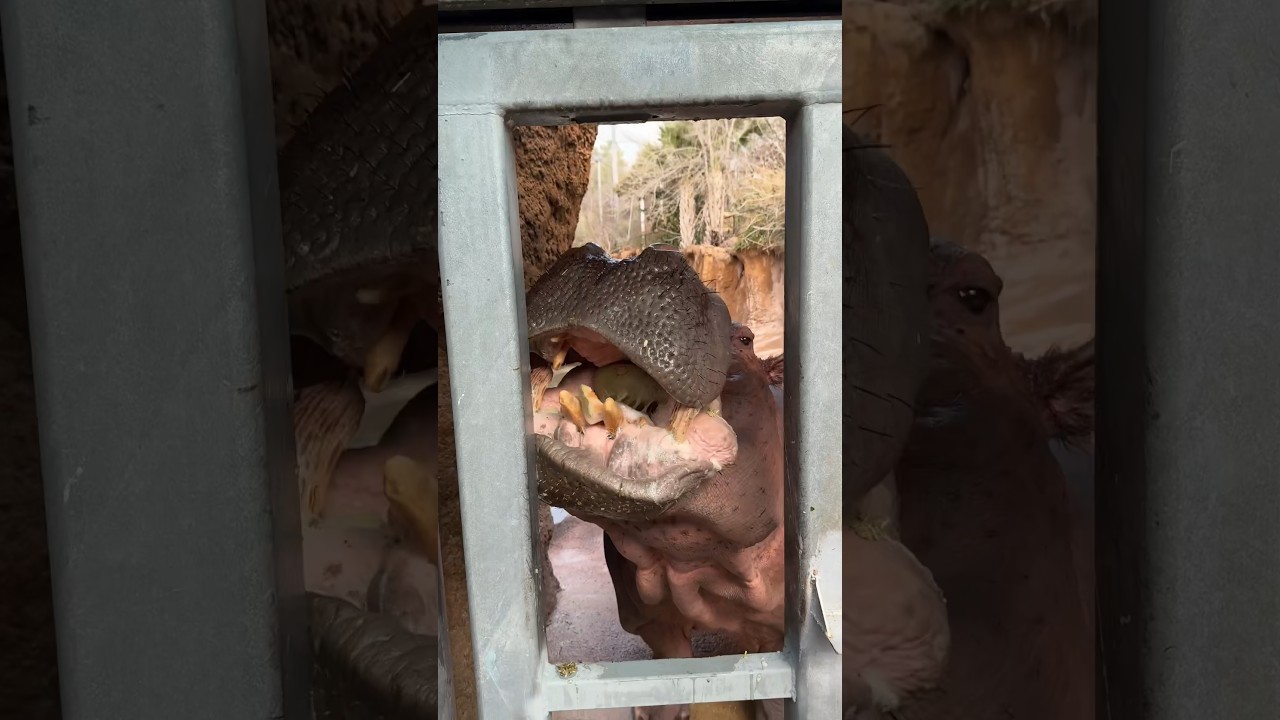– Discover the playful nature of hippos and their surprising dietary habits.
– Learn how the seemingly mundane activity of a hippo eating cantaloupe can provide insights into animal behavior.
– Explore the importance of environmental enrichment for animals in captivity to ensure their overall well-being.
Imagine yourself on a typical sunny afternoon, strolling through the gentle pathways of your local zoo. Your steps are leisurely, your mind at ease, and right when the mundane thoughts of everyday life start to creep back in, you halt. A peculiar chomping sound strikes your ear. It’s rhythmic, wet, and oddly satisfying. You stroll over to the source of this curious concert, and there it is – a massive, barrel-shaped creature, its glistening skin barely protruding from the water. It’s a hippopotamus, and it’s engaging in a rather unexpected snack time, crunching down on a juicy cantaloupe as if it’s the finest delicacy.
You might wonder, what could be so riveting about watching a hippo munch on fruit? It’s not the act itself that’s so fascinating, but rather the weave of biology, animal behavior, and the meticulous care that goes into the lives of these semi-aquatic giants – especially when in the care of humans.
Starting with the food choice, cantaloupe is not an item you’d typically find on the menu for a creature like Hippopotamus Amphibius. Hippos are known to be herbivorous grazers, and their diets mainly consist of grasses they consume during nocturnal forages. Yet, here’s where understanding of wildlife and species-specific care becomes apparent. Melons, like cantaloupe, can serve as a form of enrichment — a tool caretakers use to keep animals mentally stimulated and physically active. Yes, animals, much like our own kind, require variety, novelty, and challenges to thrive, be it puzzle feeders for birds, scent trails for carnivores, or cantaloupe for hippos.
This scene of hippo-cantaloupe crunching is more than just a quirky spectacle; it underscores the importance of environmental enrichment’s role in the psychological and physical health of animals under human care. This practice is vital for maintaining an animal’s natural behaviors. It provides a stimulating environment that mirrors their wild habitat as closely as possible, thus preventing the boredom and stress accompanying life in a more confined space.
Enrichment can take many forms, from physical structures like climbing frames and varied terrain to sensory stimuli such as different scents or sounds and even cognitive challenges that incite natural problem-solving behavior. Each species has its own set of environmental needs, a reality that skilled caretakers cater to with great consideration. For hippos, the simple inclusion of a cantaloupe, floating like a buoyant orb in their aquatic abode, encourages their natural foraging tendencies and dexterous mouth movements. It’s a testament to the meticulous design of diet and habitat, which fosters an enriching life for this majestic megafauna.
Beyond the confines of zoo life, these practices also have real value in conservation efforts. Understanding the fundamentals of animal care and enrichment not only uplifts the lives of captive animals but also aids in rehabilitating and releasing species back into the wild. It’s a symphony of care and knowledge being played out, with wildlife experts and zookeepers as the masterful conductors.
But what about the hippos in the wild? What does their munching on melons not native to their environment tell us about adaptability and diet? Here arises the profound link between animal behaviorists and their subjects. Careful observation of animals in captivity can yield insights that inform our understanding of their needs and survival strategies in the wild. It turns out hippos are more than grazers; they can be opportunistic in their food choices when the environment or circumstances allow.
As we dive deeper into understanding these creatures, we see reflections of broader ecological tales. Consider the hippo’s role as an ecosystem engineer in its native African habitats. By grazing on vast swathes of grassland, these animals help shape the landscape, indirectly influencing the distribution of plant species, which in turn affects the habitat available for other wildlife. They are not mere animals but key players in their ecosystems.
Moreover, hippos’ social dynamics are nothing short of intriguing. These giants are not the solitary behemoths one might expect; they are highly social, with complex hierarchies and group interactions. Observing hippos together, whether in the consistency of captive cohorts or the fluid congregations in the wild, reveals a network of relationships and communications, complete with vocalizations likened to grunts, wheezes, and even laugh-like calls.
Let’s return to our zoo, where the hippo, now finished with its cantaloupe, retreats into the cool depths of its pool. The allure of these animals extends beyond their unconventional eating habits; it lies, in fact, in the mosaic of care, biological wonders, and ecological significance they represent. To watch a hippo at a zoo, engaging with its environment thoughtfully arranged by human hands, is to peek into the comprehensive approach needed to sustain and respect wildlife.
In closing, seeing a hippo with a cantaloupe may be a mere drop in the vast ocean of natural wonders, yet it encapsulates a universe of understanding. It invokes our curiosity, compels us to explore the finer details of animal care, and beckons us to respect the intricate balance of the natural world. Through thoughtful observation and engagement, we can transform our casual stroll through the zoo into a gateway to the broader narrative of wildlife conservation, which plays a crucial and ongoing role in ensuring the vibrancy and diversity of life on Earth.
So, the next time you find amusement in a hippo crunching away on a slice of melon, know that the moment carries far more significance than a simple spectacle. It’s a snippet of nature’s beauty, complexity, and interconnectivity – a poignant reminder that every act, care, and crunch matters in the grand tapestry of life.
*****
Source Description


